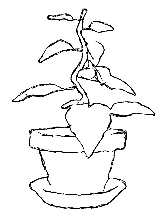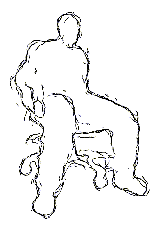 |
 |
 |
Cassidy Curtis
In narrative character animation, engaging the viewer and conveying emotion and personality are of the highest importance. Early in the development of the medium, animators learned that an effective way to achieve these goals was to "present a unified single idea with nothing complicated, extraneous, or contradictory in its makeup."[1] But this principle is seldom applied successfully in computer animation because of the demands of photorealistic rendering.
Photorealism, like pornography, leaves nothing to the imagination. It presents the viewer with a world of objects complete with volume and texture, which is far more information than the viewer needs to get the point. Furthermore, unless great effort is devoted to every detail of modeling, shading, and lighting, much of that information will actually contradict the central idea, distracting the viewer. The need to cancel out these spurious impressions places an unreasonable demand on the animator.
A hand-drawn sketch can convey a lot of information in a much simpler package, if one draws only what is necessary. The gesture of line can also convey the energy of the artist's hand, or a character's mental state. And because a sketch is clearly an artist's interpretation of the world, it encourages the viewer to complete the picture by imagining the details that are missing. This engages the viewer's mind in a way that a photorealistic image cannot.
A filter for converting a 3-D animation into a sequence of gestural sketches promises to be a powerful tool for motion testing, or for creating finished animations in a non-photorealistic style. This sketch describes one approach to implementing such a filter.
The "loose and sketchy" filter automatically draws the visible silhouette edges of a 3-D model using image processing and a stochastic, physically-based particle system. For input, it requires only a depth map of the model (fig. 1) and a few simple parameters set by the user. First, the depth map is converted into two images:
 |
 |
 |
Next, particles are generated, one at a time, for a fixed number of
particles. Each particle's initial position is chosen at random from
within the template image, with a bias toward areas that need more
ink. (No particles are ever born in areas that need no ink.)
Acceleration at each timestep is based on the force field, with
additional coefficients for randomness and drag. The particle is
rendered onto the canvas as an antialiased line segment. If a
particle wanders into an area that needs no more ink, it dies and a
new one is born in another random place. The particle also erases the
dark pixels from the template image as it travels, so that those edges
will not be drawn again. (This aspect of the technique is similar to
previous approaches to pen-and-ink rendering [2, 3].)
By tweaking drag and randomness, a continuous gamut of styles can be
generated ranging from a tightly controlled technical drawing (fig. 4)
to a loose and gestural sketch (fig. 6). The higher the drag, the
tighter the style. These parameters also affect the character of
motion, which can range from near-perfect smoothness to a lively
staccato. The looser styles are particularly appropriate for animated
characters, giving them a bit of life even when they stand perfectly
still. It is also worth noting that for animation, it is not
necessary to exactly render all of the silhouette edges all of the
time. An error in a single frame will usually go unnoticed, because
each frame lasts only a fraction of a second.
 |
 |
 |
Figures 7-11 show just a few of the other styles available by varying
these and other parameters. Each of these images took only 10-60
seconds to compute.
 |
 |
 |
 |
 |
[1] Frank Thomas and Ollie Johnston, "Disney Animation: The Illusion of Life", Abbeville Press, New York, 1981.
[2] Michael P. Salisbury, Michael T. Wong, John F. Hughes and David H. Salesin, "Orientable Textures for Image-Based Pen-and-Ink Illustration", Proceedings of SIGGRAPH 1997.
[3] Greg Turk and David Banks, "Image-Guided Streamline Placement",
Proceedings of SIGGRAPH 1996.
